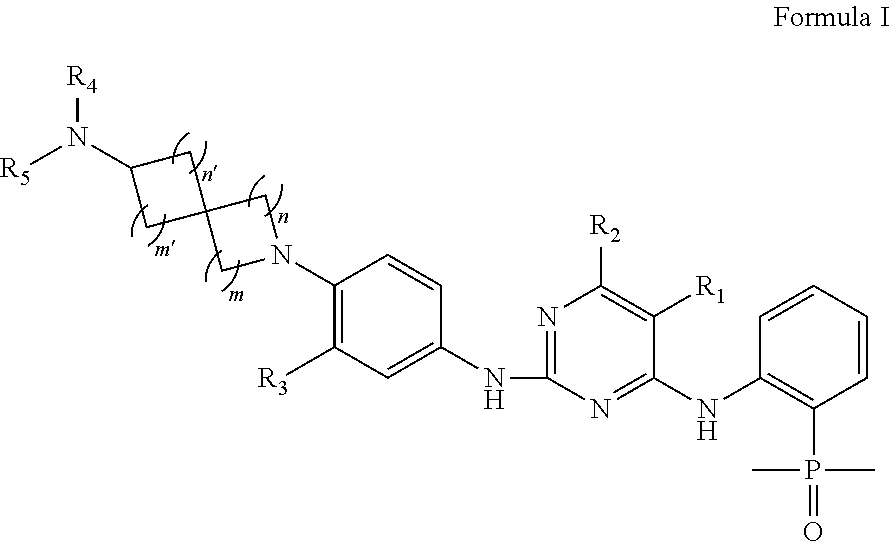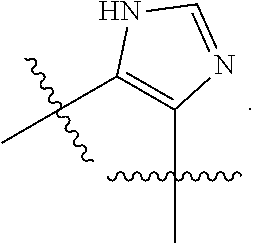EGFR Inhibitors, Compositions and Methods Thereof
a technology of egfr inhibitors and compositions, applied in the field of egfr inhibitors, can solve problems such as drug resistan
- Summary
- Abstract
- Description
- Claims
- Application Information
AI Technical Summary
Benefits of technology
Problems solved by technology
Method used
Image
Examples
example 1
[0125]Synthesis of Compound 1
(2-((5-chloro-2-((4-(7-(dimethylamino)-2-azaspiro[3.5]nonan-2-yl)-3-methylphenyl)amino)pyrimidin-4-yl)amino)phenyl)dimethylphosphine oxide
[0126]
Step 1: Synthesis of 2-azaspiro[3.5]nonan-7-one trifluoroacetate
[0127]To a stirred solution of tert-butyl 7-oxo-2-azaspiro[3.5]nonane-2-carboxylate (2.0 g) in DCM (30 mL) was added TFA (10 mL). The reaction mixture was stirred at room temperature for 2 h. After completion of the reaction (monitored by TLC), the reaction mixture was evaporated under reduced pressure to obtain 2-azaspiro[3.5]nonan-7-one trifluoroacetate (3.0 g) as a yellow oil.
Step 2: Synthesis of 2-(2-methyl-4-nitrophenyl)-2-azaspiro[3.5]nonan-7-one
[0128]To a solution of 2-azaspiro[3.5]nonan-7-one trifluoroacetic acid salt (3.0 g) and 1-fluoro-2-methyl-4-nitrobenzene (1.5 g) dissolved in DMSO (30 mL) was added K2CO3 (1.5 g). The reaction mixture was stirred at 90° C. overnight. The reaction mixture was cooled down to room temperature and diluted w...
example 2
Synthesis of Compound 2
(2-((5-chloro-2-((3-methyl-4-(7-(methylamino)-2-azaspiro[3.5]nonan-2-yl)phenyl)amino)pyrimidin-4-yl)amino)phenyl)dimethylphosphine oxide
[0133]
[0134]To a solution of 2-(4-((5-chloro-4-((2-(dimethylphosphoryl)phenyl)amino)pyrimidin-2-yl)amino)-2-methylphenyl)-2-azaspiro[3.5]nonan-7-one (60 mg) in MeOH (4 mL) was added methanamine (0.5 mL, 2N in THF) and AcOH (2 drop). The mixture was stirred at room temperature. After 1 h, sodium cyanoborohydride (30 mg) was added and the mixture was further stirred at room temperature for 1 h. After completion of the reaction (monitored by TLC), the reaction mixture was diluted with DCM (30 mL). The resulting solution was washed with 10% NaHCO3 aqueous solution and NaCl saturated aqueous solution. The mixture was dried over anhydrous magnesium sulfate and concentrated under vacuum. The residue was purified by column chromatography over silica gel with DCM / MeOH (8:1). This obtained 25 mg of compound 2 (2-((5-chloro-2-((3-methyl-...
example 3
Synthesis of Compound 3
(2-((2-((4-(7-amino-2-azaspiro[3.5]nonan-2-yl)-3-methylphenyl)amino)-5-chloropyrimidin-4-yl)amino)phenyl)dimethylphosphine oxide
[0135]
[0136]To a solution of 2-(4-((5-chloro-4-((2-(dimethylphosphoryl)phenyl)amino)pyrimidin-2-yl)amino)-2-methylphenyl)-2-azaspiro[3.5]nonan-7-one (70 mg) in MeOH (4 mL) was added ammonium acetate (51 mg) and AcOH (2 drop). The mixture was stirred at room temperature. After 1 h, sodium cyanoborohydride (25 mg) was added and the mixture was further stirred at room temperature for 1 h. After completion of the reaction (monitored by TLC), the reaction mixture was diluted with DCM (30 mL). The resulting solution was washed with 10% NaHCO3 aqueous solution and NaCl saturated aqueous solution. The mixture was dried over anhydrous magnesium sulfate and concentrated under vacuum. The residue was purified by column chromatography over silica gel with DCM / MeOH (8:1). This obtained 29 mg of compound 3 (2-((2-((4-(7-amino-2-azaspiro[3.5]nonan-2...
PUM
| Property | Measurement | Unit |
|---|---|---|
| weight | aaaaa | aaaaa |
| temperature | aaaaa | aaaaa |
| temperature | aaaaa | aaaaa |
Abstract
Description
Claims
Application Information
 Login to View More
Login to View More - R&D
- Intellectual Property
- Life Sciences
- Materials
- Tech Scout
- Unparalleled Data Quality
- Higher Quality Content
- 60% Fewer Hallucinations
Browse by: Latest US Patents, China's latest patents, Technical Efficacy Thesaurus, Application Domain, Technology Topic, Popular Technical Reports.
© 2025 PatSnap. All rights reserved.Legal|Privacy policy|Modern Slavery Act Transparency Statement|Sitemap|About US| Contact US: help@patsnap.com



